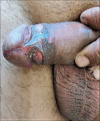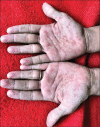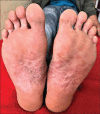The Changing Trend of Syphilis: Is It a Sign of Impending Epidemic?
- PMID: 37151273
- PMCID: PMC10162747
- DOI: 10.4103/ijd.ijd_788_22
The Changing Trend of Syphilis: Is It a Sign of Impending Epidemic?
Abstract
Background: Syphilis is a treatable bacterial infection caused by Treponema pallidum. There has been a change in incidence of syphilis in various nations over the years.
Aim: To study the epidemiological trends, demographic profile, high-risk behaviour, clinical pattern, and stage of syphilis over the last ten years in patients presenting to an STD clinic in a tertiary care hospital.
Material and methods: This was a retrospective observational study over ten years. Records of all confirmed syphilis cases were analysed in relation to demography and clinical profile.
Results: There were a total of 3,110 STD patients among whom 31 cases (accounting for 0.99%) of confirmed syphilis were seen. There was a significant increase in cases in the last five years of study, especially in the last year. An increase in primary (PS) and secondary syphilis (SS) was observed. Males outnumbered females (3:1). Mean age of patients was 35.0 ± 11.53 years. Professionals were most common (22.6%) having syphilis followed by farmers (19.35%). A significant proportion (45.1%) of our patients were at least graduates. Unprotected sex was seen in all the patients followed by extramarital/premarital sex (71.35%). There were 16.12% of cases who had a history of paid sex and 9.7% were homosexuals. SS and latent syphilis were more common (38.7% each) than PS (19.35%). In PS single chancre and in SS truncal asymptomatic rash was the commonest clinical presentation. Limitation: Single-centre study, including only self-reported patients leading to a small sample size, is the major limitation of the study.
Conclusion: The increased trend of primary and secondary syphilis in recent years highlights that there is a risk of an impending epidemic.
Keywords: High-risk behaviour; latent syphilis; primary syphilis; secondary syphilis; syphilis.
Copyright: © 2023 Indian Journal of Dermatology.
Conflict of interest statement
There are no conflicts of interest.
Figures







References
-
- Australian Government Department of Health. “Third national sexually transmissible infections strategy 2014–2017. ‘2014. Australian Government Department of Health. Available from: https://consultations.health.gov.au/ohpd-health-protectionpolicybranch/t....
-
- GoI/NACO/Monitoring & Evaluation/Sankalak: Status of National AIDS Response (Third edition, 2021)/251121) Available from: http://naco.gov.in/sites/default/files/Sankalak_Status_of_National_AIDS_....
LinkOut - more resources
Full Text Sources
Research Materials
